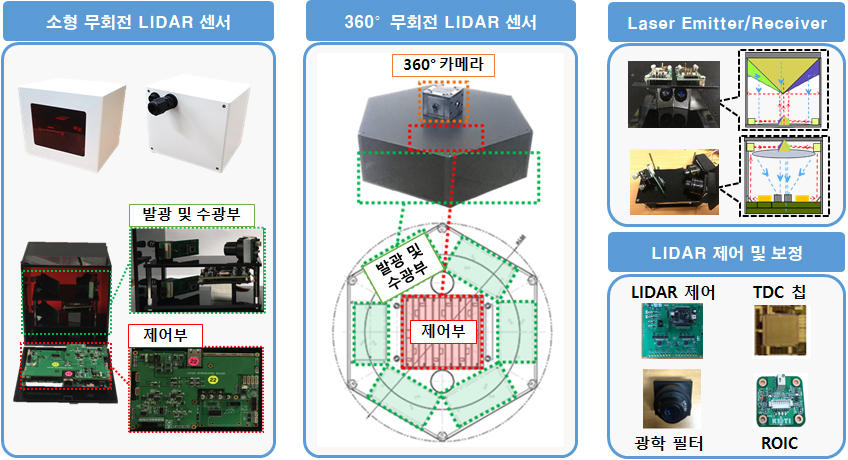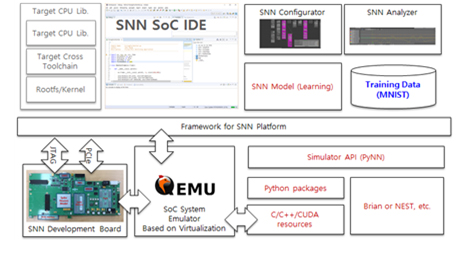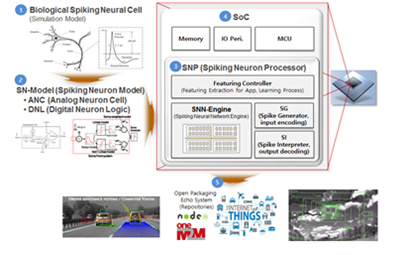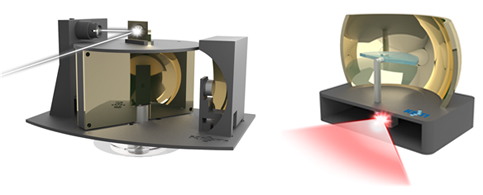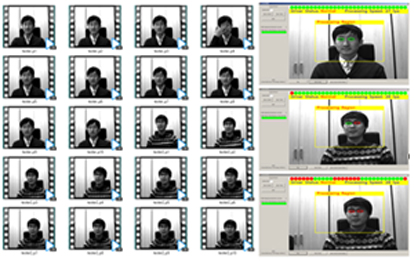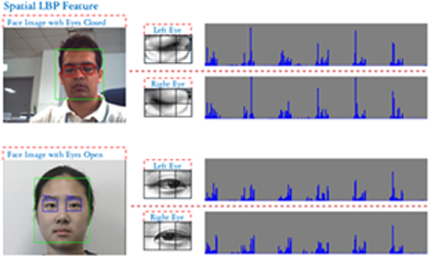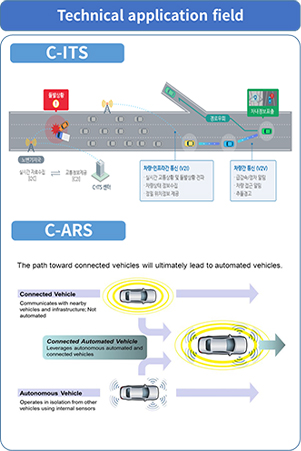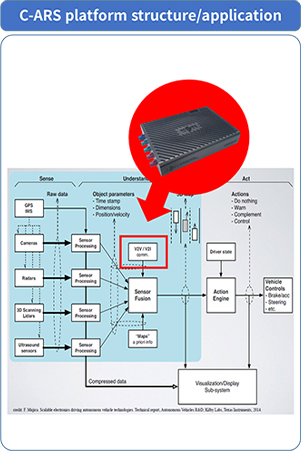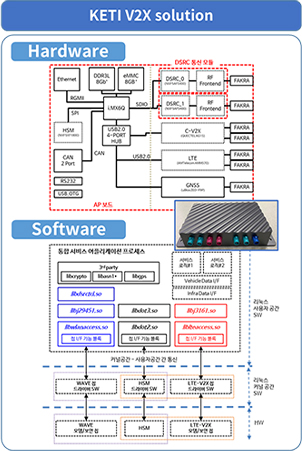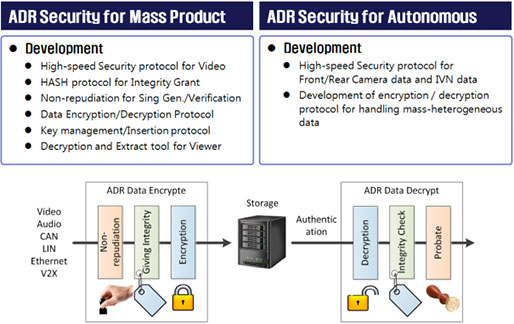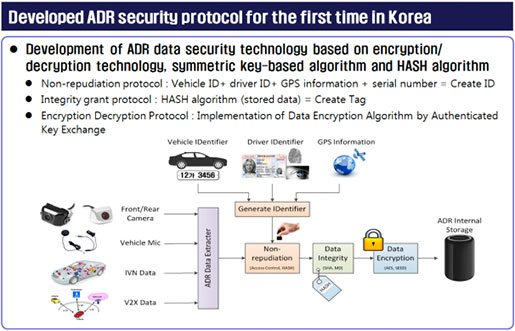Autonomous Driving
- Concept
-
A non-rotating 360° lidar sensor and its signal processing technology for a self-driving vehicle’s real-time surrounding scanning
- Main Features
-
A platform, an optical system, a light emitter & receiver and a controller for real-time, non-rotating 360° lidar scanner
- An optical system and a non-rotating reflector for 360° light emission, a cylinder-type high-definition detector array and a light emitter & receiver controller
An affordable lidar system with competitive advantages for commercialization compared to Velodyne’s motor-type HDL-64e
- Applications
-
Autonomous VehicleSecurityFactory
- Concept
-
A SoC design technique that allows ultra-low power parallel/distributed computing by mimicking how the brain functions
- Main Features
-
Spiking neural network (SNN) and SoC platform technologies for a network of up to 1,024 spiking neurons for autonomous deep learning (under development and expected to be completed in 2021).
- SNN stability and operability are secured for up to 1,024 neurons with a power consumption of 20nW/cell.
An 8-/32-bit processor and CPU core (MENSA) design technique
- KETI has its own low-power SoC IP and 8-/32-bit RISC processor core (MENSA-core) by developing an Intel 8051-compatible core and improving the RISC method and caching design.
Competitive advantage in performance and price with the involvement of more neurons (1,024) than other SNN technologies by existing IoT industry leaders.
- Applications
-
Autonomous driving and IoT devicesWearables
- Concept
-
A scanning lidar platform with a rotating mirror for an autonomous vehicle’s real-time surveillance of surroundings
- Main Features
-
A mirror-rotating, 16-channel lidar sensor (available) and non-motor-based next-generation lidar (under development)
- Maximum measurement range of 200 m, 15/30Hz scan speed
- Maximum 140° horizontal field of view (FOV), 0.125°/0.0625° angular resolution, and -40°C to 85°C operating temperature range
- Readily applicable to existing lidar products for autonomous driving
Competing with Ibeo’s 8-channel Lidar for self-driving vehicles
- Applications
-
Autonomous vehicleSecuritySubway screen doorManufacturing safety
- Concept
-
A visual censor-radar fusion vision system for the surrounding and obstacle recognition of autonomous vehicles
- Main Features
-
A video sensor-based vehicle-mounted road surface, curve and grade recognition system
- Driving safety technology using multi-object (of three or more different types) detection
- 15 fps processing speed for the recognition of a 150 mm high speed bump and other multiple objects
Competing with Mercedes-Benz's Magic Body Contol and Mobileye’s camera-based Advanced Driver Assistance Systems (ADAS) solution
- Applications
-
Autonomous vehicle (level 3 or higher ADAS)Intelligent security system
- Concept
-
An IR camera-based advanced driver assistance system (ADAS) that provides feedbacks by monitoring a driver’s state (drowsiness, drunk-driving, fatigue, eyes off the road, etc.) and driving habits
- Main Features
-
An IR camera and embedded system-based intelligent image recognition system technology for the development of a driver attention warning system for commercial vehicles
- 23 fps or faster processing speed on a 1 GHz (dual-core) CPU embedded system
- Steady driver drowsiness recognition with/without sunglasses or glasses
- Stable embedded system technology development through ISO26262 software quality management, gap analysis, and ASIL allocation
Outstanding performance at a lower price than other domestic competitors, with a 95-98% success rate of driver state recognition with sunglasses
- Note: company H’s driver monitoring system has 15 recognition constraints (driver wearing sunglasses, smoking, talking on the phone, etc.)
- Applications
-
Logistics / transportationADAS
- Concept
-
Hybrid V2X communication technology supporting heterogeneous communication and global standards
- Main Features
-
Hybrid V2X hardware platform design technology
- Communication method: DSRC(WAVE) 2ch, LTE-V2X 1ch, LTE 1ch
- V2X standards: IEEE 802.11p, 3GPP Rel.14
Hybrid V2X software solution
- Communication method: DSRC(WAVE), LTE-V2X
- V2X standards: IEEE 1609 + SAE J2945/1(Korea, USA), ETSI GeoNetworking(Europe)
Technology maturity at the level of commercialization
- Application of many C-ITS pilot projects in Korea
- Application of domestic and overseas V2X communication certified test equipment solution
Expandability
- Expansion into 5G and 5G-V2X communication
- Applications
-
Cooperative Autonomous DrivingC-ITSPlatooning
- Concept
-
Technology for the recording and encryption of pre- and post-accident data including audio and video inside and outside a vehicle, surrounding sensor data, V2X communication and in-vehicle network (IVN) data
- Main Features
-
Hashing and encryption/decryption technology for autonomous vehicles to record accident data
Security protocols for high-speed communication, prevention of driving data tampering, and verification of accident data integrity
- Real-time (less than 15 ms latency) security technology for FHD front video (30 fps) and HD rear video
- One-time password (OTP)-based lightweight security algorithm
- Security technique using a hardware security module (HSM)
No existing competition
- Event data recorders (EDR) are manufactured and sold for commercial vehicles, in accordance with IEEE 1616, SAE J1698 and other international standards. However, they have limitations in recording surrounding sensor, multi-channel video and V2X communication data which are required for autonomous driving.
- Applications
-
Autonomous vehicle
Copyright(C) 2016 KOREA ELECTRONICS TECHNOLOGY INSTITUTE., All Rights Reserved.


